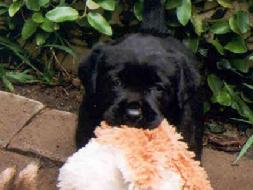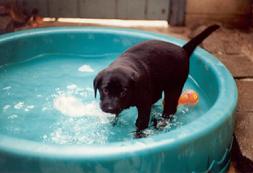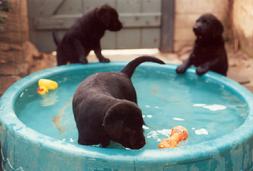Puppy Pre-School
There are a number of things that you can do at home with you puppy in anticipation of your first field day. Generally, I do not like to take pups under the age of six months out in the field and expose them to parvo, corona virus or other diseases that they may come into contact with from other dogs or wild animals. Besides, there is plenty they can learn and do at home those first few months.
You can start litters at 4 weeks of age with lots of small soft and small squeaky toys in their bed. By 5 weeks, pups will pick up, carry and play with toys. Encourage chasing, picking up and bringing toys back to you. Throws of 6' get pups started with the "retrieve" concept which should be second nature to them even at that age. You need to get each pup by himself (to avoid sibling distractions) and toss his toy a few feet. As soon as he picks it up, encourage him to come back to you. ("Pup, pup" works well). Common behavior is to run out, pick up toy, drop toy, and run back to you. Give lots of hugs and "good boy" when a pup does anything right.
|
 |
| 5 weeks old |
|
| |
It is also recommended that you have a child's play pool for pups to play in. Initially, the water shouldn't be more than a few inches deep, and pups should be able to climb in and out of the pool without difficulty. Avoid any possibility of bad experiences by being there to monitor water play by young pups. By 6-7 weeks of age, pups should show interest in retrieving squeaky toys out of the play pool. Be sure to let pups know that they did something really good by giving lots of praise for retrieving items from the pool.
|
 |
| 7 weeks |
|
|
 |
| 7 weeks |
|
|
Encourage your pup to explore both in your house and in your backyard. Hide toys or treats for pup to find behind bushes or sofas. Again, give lots of praise and encouragement when he does find his treat.
By 7 weeks you can begin your introduction to "Feathers 101". Using either a dead pigeon, a pigeon (or other game bird) wing, or a live shackled pigeon, hold pup and let him smell and taste the feathers. Toss the bird a few feet and encourage pup to pick it up. For the first few experiences, pup may be hesitant to pick it up in his mouth. Don't push it! Keep bringing the feathers out and tossing them for him every day. Don't make lessons longer than 2 minutes with a young pup; their attention span is very short, and going longer will only upset the pup. After two minutes, stop whatever you are working on. If pup sees lessons as an ordeal, you are going to have a serious problem doing any training! Once pup does pick up the feathers, give him lots of praise. Encourage him to come back to you and give him lots of pets. DO NOT grab the feathers out of his mouth. Tell pup "give" and gently take the feathers.
|
You should teach your pup the commands "Sit", "Come", "Fetch", "Hold", "Give", and their name. Start with "Sit" at about 9-10 weeks. As with all obedience commands, use lots of repetition and lots of praise. Don't expect 100% obedience at 6 months of age! Start using "Come" instead of "Pup, pup" when calling pups to feeding time at 5-6 weeks. Initially, you may find combining the words "Pup, pup" and "Come" gets the desired response. Then you can slowly stop using "Pup, pup" and use only the command "Come". "Sit" is pretty easy for most pups to learn, especially if you combine the command with food treats. A small treat, held in front of and above the pup's nose will automatically get pup into a sit. Also, gently pushing pup's rear down with oine hand while holding his chest stationary with your other hand an giving the "Sit" command works well. First time pup sits on command deserves lots of praise. Start using the command "Fetch" as soon as your pup starts picking up toys. Encourage your pup to take the toy in his mouth and say "Fetch". By 4 months of age, start "Fetch" with a bumper. Again, repetition and patience will pay off. To teach "Hold" have a pup walk with you in a confined area with his bumper in his mouth while you repeat "Hold, hold, hold". Watch pup carefully, and as soon as he looks like he is going to drop the bumper, repeat "Hold" and place you hand under his chin to keep the bumper in his mouth. Do not extend lessons beyond 2-3 minutes, and keep them fun with lots of praise for things done correctly. The old adage "You catch more flies with honey....." applies to dog training quite well.
|
During the 4-6 month age period, do regular daily retrieves in your backyard with a bumper or pigeon. If pup tends to run somewhere other than to you once he has picked up his bumper or bird, set up your retrieves in a long narrow area where pup has no option but to come to you. For indoor retrieves, a hallway works well. Again, use lots of encouragement and the command "Come". Keep practicing "Come", "Sit", Fetch" and "Hold" on a regular basis. Then, by the time pup is ready for his first field day, you can concentrate on retrieving, not basic obedience work.
Have fun!
|
|
|